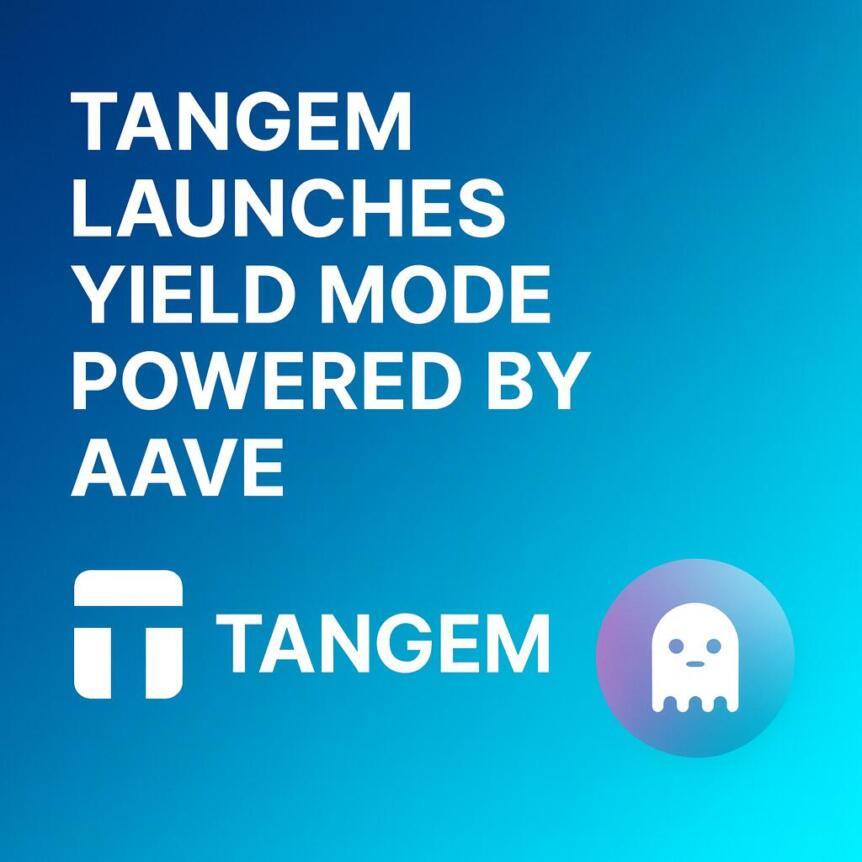
Tangem Launches Yield Mode Powered By Aave
A New Chapter for Self-Custody
For years, hardware wallets focused on one goal: keeping assets safe. Users held their private keys offline and avoided centralized risks. Tangem's Yield Mode builds on that foundation by giving users access to decentralized finance without giving up control or navigating complex platforms. Everything happens inside the Tangem app, with verified hardware security protecting the private keys at all times.
What Exactly Is Yield Mode?Yield Mode is a built-in feature that lets users supply supported assets to Aave, one of the most trusted DeFi protocols in the ecosystem. When a user activates Yield Mode for a token, the Tangem smart contract supplies that token to Aave's liquidity pools, where it can be lent to borrowers. In return, users earn yield based on Aave's real-time supply and demand rates.
Once enabled, any new funds arriving in the wallet for that blockchain can be automatically supplied to Aave. The entire process is transparent, simple, and managed inside the Tangem interface, removing the need for WalletConnect or external dApps.
Why Aave?Aave is one of the largest and most established DeFi protocols, launched in 2017 on Ethereum as an open-source, non-custodial liquidity platform. It allows anyone to lend or borrow cryptocurrencies through smart contracts instead of traditional financial intermediaries.
The protocol manages billions in total value locked and has become a cornerstone of DeFi due to its security, transparency, and consistent innovations. Its liquidity pools offer variable interest rates that adjust according to market conditions.
For Tangem users, Aave provides a strong combination of safety, liquidity, and yield potential.
Full Liquidity, No LockupsOne of the biggest advantages of Tangem's Yield Mode is that users stay fully liquid. Assets supplied to Aave can be withdrawn at any time because Aave's liquidity pools are designed for instant access. Even while generating yield, users can still send, receive, and swap their tokens directly from the Tangem app.
Withdrawals are almost always immediate, and Tangem 's backend can trigger urgent withdrawals if the Aave protocol becomes vulnerable. This level of flexibility is rare in yield-generating services, where funds are often locked for days or weeks.
Secure and Audited Smart ContractsTangem's smart contract acts as a secure bridge between the wallet and the Aave protocol. It manages token approvals, routes assets, collects yield, and handles withdrawals. Since it interacts directly with user funds, it has been fully audited to guarantee transparency and protection.
The source code of the smart contract is available publicly, allowing users and developers to verify that it matches the audited version. This replaces blind trust with verifiable, on-chain security.
How to Get StartedUsing Tangem Yield Mode takes only a few steps:
Open the Tangem app Select a supported token such as USDT or USDCTap“Get Started” Review the APY and associated fees
Confirm and activate Yield Mode
After setup, the wallet automatically supplies the chosen assets to Aave whenever they arrive in the wallet.
A Simple Way to Earn on Your CryptoTangem's new Yield Mode offers a smooth and secure entry point into decentralized finance. It combines Tangem's well-known hardware protection with Aave's proven liquidity infrastructure, giving users a safe, liquid, and user-friendly way to earn yield on their stablecoins.
With no lockups and no complicated interfaces, Tangem moves self-custody to the next level by making yield generation accessible to everyone.
Crypto Investing Risk WarningCrypto assets are highly volatile. Your capital is at risk. Don't invest unless you're prepared to lose all the money you invest.
Legal Disclaimer:
MENAFN provides the
information “as is” without warranty of any kind. We do not accept
any responsibility or liability for the accuracy, content, images,
videos, licenses, completeness, legality, or reliability of the information
contained in this article. If you have any complaints or copyright
issues related to this article, kindly contact the provider above.


















Comments
No comment